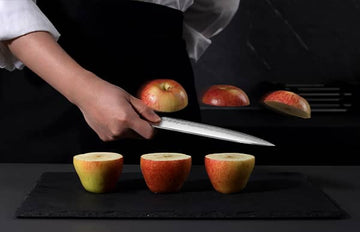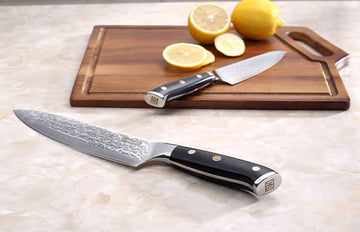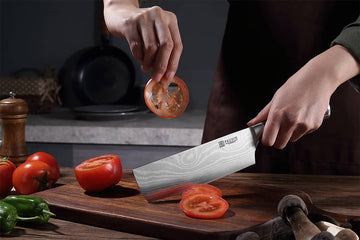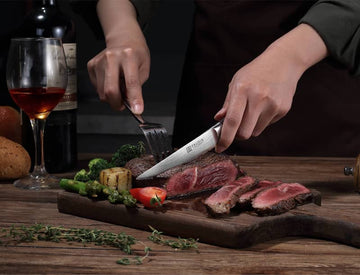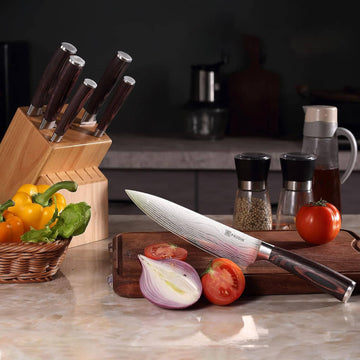First, we're going to discuss the essential knives you need for your kitchen. We will go through why these are the crucial knives as we go along. We'll be referencing knives from our Ultra Dark Collection.

- Size: 8"
- Blade: Curved
- Good at: Slicing meat and fish, chopping herbs, and cutting vegetables
- Not Best for: Cleaving meat bones, slicing bread, peeling, mincing
A chief's knife is shaped in such a way where it's perfect for rocking back and forth along your chopping block. This allowance comes from the curved blade and easy-to-grip handle.
The heel, or back of the blade, is thick enough to provide for an ample grip. The extra grip makes this suitable for cutting hard-to-chop foods like onions.

- Size: 8"
- Blade: Serrated
- Good at: Cutting bread, cakes, or tomatoes
- Not Best for: Everything else
A bread knife is also known for its easy-to-grip handle. A serrated edge complements the larger surface area of the blade. The blade's edge makes it incredibly suitable for cutting through softer objects.
It works as a substitute for a cake leveler in a pinch. The sawing motion is sure to coat the blade with frosting without flattening the delicious underneath of your pastry.
Bread knives are also uniquely good at cutting squishy tomatoes. The lack of pressure needed ensures you don't crush your tomato in the process of cutting it.

- Size: 5"
- Blade: Curved
- Good at: Cutting smaller fruit and vegetables and precise cutting work
- Not Best for: Larger and more hardy plants
The sharp tip of a utility knife makes it suitable for detailed work. The smaller blade is not ideal for big cuts of meat. Instead, this blade is best for detail-oriented kitchen tasks.
You'll also notice the handle is comparable to a chef's knife, making it relatively easy to grip. It is also similar to our next knife.

- Size: 3.5"
- Blade: Curved
- Good at: Delicate tasks like removing seeds or peeling the outer layer
- Not Best for: Cutting large chunks of meat or tough vegetables
The smallest knife in your kitchen arsenal should be a paring knife. Where a utility knife is for more delicate tasks, a paring knife handles thinner layers.
Precision work behind this make includes peeling thin layers from sensitive vegetables. Regardless, the thickness of this blade should ideally be around 2mm to ensure toughness.
The handle should still be comfortable, regardless of the size of the blade. Thankfully, 3.5" is still a notable blade, so even large hands should be able to tolerate this. A good manufacturer will account for an ergonomic handle.
The Best Knife for Preparing Meat
If your house is known for preparing different pieces of meat, here is your section. Meat knives are known for doing two things: removing bones and providing clean cuts.

- Size: 6"
- Blade: Curved
- Good at: Removing bones from meat (beef, poultry, or fish)
- Not Best for: Anything else
To properly debone chicken (or any other meat), you need a long and thin blade. A boning knife is explicitly for maneuvering around bones. The semi-flexible edge is good enough to bend into its work a bit.
Regardless of any bending, a good boning knife is sturdy enough to last through hundreds of uses. If your household enjoys cooking entire hunks of meat, a boning knife would be an excellent addition to your home.

- Size: 12" (or more)
- Blade: Straight
- Good at: Carving large portions of meat from the bone
- Not Best for: Cutting bread or fruit
A ham knife, otherwise known as a Jamonero knife in some circles, is excellent at removing bone. It is a mildly flexible blade, making it somewhat similar in design to filleting knives of boning knives.
These days, carving knives and boning knives fill the void of ham knives. Both can turn large portions of meat into thin slices to share around the dinner table.

- Size: 8"
- Blade: Straight
- Good at: Cutting thin slices of meat or filleting large fish
- Not Best for: Cutting bread
As discussed earlier, a carving knife is typically in place of a ham knife for cutting large portions of meat. Carving knives are also suitable for filleting and deboning larger fish.
This type of knife is ideal for creating that Thanksgiving experience. Don't be surprised if you end up fighting with someone over carving the turkey.

- Size: 7"
- Blade: Straight
- Good at: Splitting meat and handling incredibly stubborn vegetables
- Not Best for: Cutting bread, pastries, or delicate fruits or vegetables
The cleaver knife is a classic design best known for splitting meat. It's one of the few blades on this list consistent with a downward chopping motion. With a blade sharp enough, you could cut an entire yellow onion into two separate sections.
The blade is not known for its length but is mainly known for its depth and width. This design allows handling heavy-duty tasks with little pressure.
The Best Knives for Fish
Fish knives are typically

- Size: 5" to 10"
- Blade: Straight or Curved
- Good at: Cutting meat, fish, poultry, vegetables, and fruit
- Not Best for: Cutting bread, pastries, or delicate fruits or vegetables
A Japanese knife is a catch-all term for specific designs. For example, this 10" Japanese Carving knife is recognized for its unique handle design and single-bevel edge.
Many of these knives are known for cutting into sushi. However, Japanese Butchery Knives are also known for filleting fish and poultry. Japanese knives are a firm form of your standard fillet knife, making them suitable for fish of all sizes.
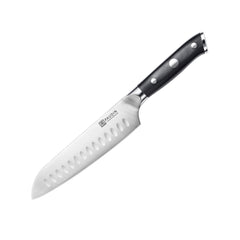
- Size: 7"
- Blade: Straight
- Good at: Cutting thin slices of meat, chicken, nuts, or vegetables
- Not Best for: Cutting bread
A santoku knife provides a unique design known for cutting thin slices of any material. It is a narrow blade known for being incredibly light to carry around.
Santoku knives are known to be hollow-edge knives, indicated by the series of divots along the blade. The design makes them more suitable for lighter tasks, making this knife ideal for making sushi.

- Size: 5"
- Blade: Serrated
- Good at: Cutting through cooked meat or bread
- Not Best for: Cutting delicate fruit or vegetables
The steak knife is an absolute classic of American use. Your alternative is to eat your steak like a lollipop, which probably makes you into a monster.
The knife blade is serrated, making it easy to cut through tougher meat like butter. The serrated edge also makes it great for smaller pieces of bread but not great for cake.
Conclusion
We hope you have an ample understanding of what blades will fit nicely inside of your home through the eleven different types of knives we have gone through. Remember that a sharp knife is not the only important factor when making a purchase. Some tools call for a serrated blade, a long blade, or a narrow blade.
Our complete selection of blades under the Ultra Dark Collection will help you complete your set. Our designs ensure an ergonomic handle with a comfortable grip.
